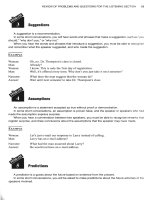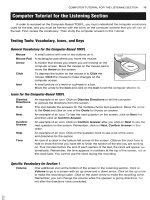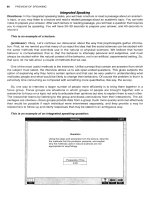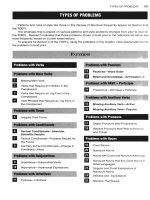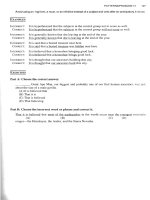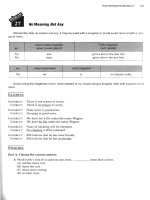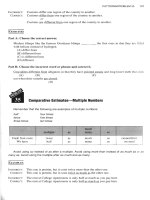Tài liệu How to prepare for the foefl part 23 docx
Bạn đang xem bản rút gọn của tài liệu. Xem và tải ngay bản đầy đủ của tài liệu tại đây (787.09 KB, 10 trang )
OVERVIEW OF
THE
READING SECTION
219
According to paragraph
2,
what behavior signals the
beginning of higher-level
thinking?
O
Smiling at people
0
Staring at the hand
0
Holding up the head
0
Showing preferences
The correct answer
is
indicated
below.
part,
aware of the surrounding world. During the
second month, many infants are awake more and
can raise their heads to look at things. They also
begin to smile at people as their visual focus and
perceptual abilities improve. Sometime between two
and three months, a universal pattern of staring at
the hand seems to occur. The frequency and length
of time spent on this activity increases, eventually
leading to swiping at objects. Hand regard, as it is
sometimes referred to, is perhaps the first step in
intellectual curiosity and problem solving. By four
months, the baby is routinely holding its head up for
several minutes, it is able to roll over, and it begins
deliberate, more coordinated activities such as
searching for things, although it may not yet be able
to grasp them effectively with its hands. The four-
month-old is beginning to show preferences for
people and objects, and is especially responsive to
familiar faces. It is also beginning to be wary of
strangers and may scream when a visiting relative
tries to pick it up.
.
-
.,
-
-
-
According to paragraph
2,
what behavior signals the
beginning of higher-level
thinking?
0
Smiling
at
people
0
Staring at the hand
o
Holding up the head
0
Showing preferences
part, aware of
the
surrounding world. During the
second month, many infants are awake more and
can raise their heads to look at things. They also
begin to smile at people as their visual focus and
perceptual abilities improve. Sometime between two
and three months, a universal pattern of staring at
the hand seems to occur. The frequency and length
of time spent on this activity increases, eventually
leading to swiping at objects. Hand regard, as it is
sometimes referred to, is perhaps the first step in
intellectual curiosity and problem solving. By four
months, the baby is routinely holding
its
head up for
several minutes, it is able to roll over, and it begins
deliberate, more coordinated activities such as
searching for things, although it may not yet be able
to grasp them effectively with its hands. The four-
month-old is beginning to show preferenms for
people and objects, and is especially responsive to
familiar faces. It is also beginning to be wary of
strangers and may scream when a visiting relative
tries to pick it up.
+
220
REVIEW
OF
READING
1
I
Which of the sentences below
Ip
best expresses the information
in the highlighted statement in
the passage? The other
choices change the meaning
or leave out important
information.
0
The active toddler phase
begins when the baby
begins to walk alone.
0
Walking alone is the
active stage of infancy
before the toddler stage.
0
Babies who walk alone
are more active when
they are toddlers.
0
When a baby walks
past infants, it starts to
play actively with
toddlers
to master locomot~on. Progress toward walking
moves through standing, pulling up, balancing, and
bouncing in place. Walking with the support of
furniture allows the baby to engage in cruising. that
is, moving about unaided by caretakers, but
supported by objects. Finally, being led by others
allows the baby to release its hold on objects and
begin to walk independently. An important implication
of this sequence of accomplishments is the
increasing independence that allows older infants to
imitate adults and explore their environments.
It has been observed that the body parts
involved in each of the stages proceeds from the
head and goes down the body, a sequence that is
referred to as cephalocaudal. Clearly, the brain and
the eyes must develop first for the baby to orient
itself, the neck muscles to keep its head upright, the
arms and hands to grasp and pull up, the torso and
finally, the legs to complete the motions required for
walking. 'wsome
'b;gwwTkS
we~alon~.~ifia~
,"
passedtrom infancy into the active toddler stage.
The
correct answer is indicated below,
best expresses the information
in the highlighted statement in
the passage? The other
choices change the meaning
or leave out important
information.
0
The active toddler phase
begins when the baby
begins to walk alone.
0
Walking alone is the
active stage of infancy
before the toddler stage.
0
Babies who walk alone
are more active when
they are toddlers.
0
When a baby walks
past infants, it starts to
play actively with
toddlers.
to master locomotion. Progress toward walking
moves through standing, pulling up, balanc~ng, and
bouncing in place. Walking with the support of
furniture allows the baby to engage in cruising, that
is, moving about unaided by caretakers, but
supported by objects. Finally, being led by others
allows the baby to release its hold on objects and
begin to walk independently. An important implication
of this sequence of accomplishments is the
increasing independence that allows older infants to
imitate adults and explore their environments.
It has been observed that the body parts
involved in each of the stages proceeds from the
head and goes down the body, a sequence that is
referred to as cephalocaudal. Clearly, the brain and
the eyes must develop first for the baby to orient
itself, the neck muscles to keep its head upright, the
arms and hands to grasp and pull up, the torso and
finally, the legs to complete the motions required for
walking.
ATsoGE~~
Re
baFy
Gals
weal one.^^
~.
passed%om infancy into the active toddler stage.
OVERVIEW
OF
THE
READING
SECTION
221
When you click on a square, the sentence will appear in the passage at the place you have chosen.
The correct answer is indicated below.
Four squares
q
indicate
where the following
sentence can be added
to the passage.
At three months,
they
are
also able to focus better,
following people and
objects that interest them.
Where would the sentence
best fit into the passage?
Four squares indicate
where the following
sentence can be added
to the passage.
At three months, they are
also able to focus better,
following people and
objects that interest them.
can raise their heads to look at things. They also
begin to smile at people as their visual focus and
perceptual abilities improve.0 Sometime between two
and three months, a universal pattern of staring at
the hand seems to occur. The frequency and length
of time spent on this activity increases, eventually
leading to swiping at objects. Hand regard, as it is
sometimes referred to, is perhaps the first step in
intellectual curiosity and problem solving.0 By four
months, the baby is routinely holding its head
up
for
.several minutes, it is able to roll over, and it begins
deliberate, more coordinated activities such as
searching for things, although it may not yet be able
to grasp them effectively with its hands. The four-
month-old is beginning to show preferences for
people and objects, and is especially responsive to
familiar faces. It is also beginning to be wary of
strangers and may scream when a visiting relative
tries to pick it up.
By five months, the baby is able to sit unaided,
grabbing objects and putting them into its mouth. By
Where would the sentence
best fit into the passage?
;%
E::
-'
L
,,
r*
!
:"-
-
cm
-
can raise their heads to look at things. They also
begin to smile at people as their visual focus and
perceptual abilities improve.0 Sometime between two
and three months, a universal pattern of staring at
the hand seems to occur. The frequency and length
of time spent on this activity increases, eventually
leading to swiping at objects. Hand regard, as it is
sometimes referred to. is Derha~s the first ste~ in
ub for several minutes, it is able lo rill over,-and it
begins deliberate, more coordinated activities such
as searching for things, although it may not yet be
able to grasp them effectively with its hands. The
four-month-old is beginning to show preferences for
people and objects, and is especially responsive to
familiar faces.0 It is also beginning to be wary of
strangers and may scream when a visiting relative
tries to pick it up.0
222
REVIEW
OF
READING
Complete
a
summary of the passage by choosing
THREE
answer choices that express the most
important ideas.
When you
click
on
a
sentence, the sentence will appear in bold. The correct answer
is
indicated below.
I
The
maturation of
the
brain
Although each baby has an individual schedule of
Late stage infants are
see, but not yet retrieve.
extends from the first to the sixth month; middle
As the brain develops, the lower structures that
control reflexes mature before the higher structures
'
Although eachbabyhasan
individual schedule of motor
mma
4
development, generalpanems
The Developmental Stages of Infancy
of growth have been observed.
The maturation of the brain
Although each baby has an individual schedule of
and body structure
motor development, general patterns of growth have
predisposes development.
been observed. These patterns present themselves
Late stage infants are
as a result of the maturation of the motor area in the
interested in objeds they can
brain and the rate at which the infant's body
see, but not yet retrieve.
structures and muscles develop. Researchers in child
Basic developmental skills are
development have proposed various theories, but
universaliy achieved in about
most have divided the stages into three basic periods
the same order in three stages
of development, including early infancy, which
of infancy.
extends from the first to the sixth month; middle
Newboms react to stimuli with
infancy, from the sixth to the ninth month; and late
instinctive responses
infancy, from the ninth to the fifteenth month.
and reflexes.
As the brain develops, the lower structures that
Motor development is
control reflexes mature before the higher structures
accomplished
from
the
head
such as
the
cerebral cortex that influences higher-
down through the
body.
order thinking. By the time that various muscles in the
When babies first learn to
neck, trunk, arms, and legs come under control,
walk, they explore, but then
return to caretakers.
+
.
-
.
-
.
- -
.
.
.
.
-
.
.
.
.
.
.
~
REVIEW OF PROBLEMS AND QUESTIONS
FOR
THE
READING SECTION
223
Integrated Reading
Directions:
In the integrated reading tasks, you will read and respond to campus and textbook reading
passages. You may take notes. After each reading, you
will
hear or see a question that requires you to re-
spond by speaking or writing. Integrated examples are shown in the Directions and Examples for Speak-
ing
in
Chapter
4
and the Directions and Examples for Writing in Chapter 7.
This Review can be used to prepare for the Paper-Based TOEFL, the Computer-Based TOEFL,
and the Next Generation TOEFL. For the most part, the same types of problems are tested on all three
formats. Most of the questions are multiple-choice.
Some of the questions on the Computer-Based TOEFL and the Next Generation TOEFL are com-
puter-assisted. Although the computer-assisted questions in this book are numbered, and the answer
choices are lettered A, B,
C,
and
D,
the same questions on the CD-ROM that supplements the book are
not numbered and lettered. You need the numbers and letters in the book to refer to the Answer Key,
the Explanatory Answers, and the Transcript for the Listening Section. On the CD-ROM, you can refer
to other chapters by clicking on the screen. The computer-assisted questions have special directions
on
the screen.
Problems like those in this Review frequently appear on the Reading Section of the TOEFL.
To prepare for the Reading Section of the TOEFL, study the problems in this chapter.
Previewing Identifying Exceptions
Reading for Main Ideas Locating References
Using Contexts for Vocabulary Referring to the Passage
Scanning for Details Reading Faster
Making Inferences
224
REVIEW
OF
READING
a
previewing
Research shows that it
is
easier
to understand what you are reading,
if
you begin with a general idea
of what the passage
is
about. Previewing helps you form a general idea of the topic
in
your mind.
To preview, read the first sentence of each paragraph and the last sentence of the passage. You
should do this as quickly as possible. Remember, you are not reading for specific information, but for an
impression of the
topic.
DIRECTIONS:
Preview the following passage. Focus on the first sentence in each paragraph and the last
sentence of the passage. Can you identify the topic? Check your answer using the key on page
485.
A
black hole is a region of space created by the total gravitational collapse of matter. It is so
intense that nothing, not even light or radiation, can escape. In other words, it is a one-way sur-
face through which matter can fall inward but cannot emerge.
Some astronomers believe that a black hole may be formed when a large star collapses
in-
ward from its own weight. So long as they are emitting heat and light into space, stars support
themselves against their own gravitational pull with the outward thermal pressure generated by
heat from nuclear reactions deep in their interiors. But if
a
star eventually exhausts its nuclear
fuel, then its unbalanced gravitational attraction could cause it to contract and collapse. Fur-
thermore, it could begin to pull in surrounding matter, including nearby comets and planets, cre-
ating a black hole.
a
Reading for
Main
Meas
By previewing, you can form a general idea of what a reading passage
is
about; that
is,
you identify
the
topic.
By reading for main ideas, you identify the point of view of the author-that
is,
what the writer's
thesis
is. Specifically, what does the author propose to write about the topic?
If
you could reduce the
reading to one sentence, what would it be?
Questions about the main idea can be worded in many ways. For example, the following questions
are all asking for the same information:
(1)
What
is
the main idea?
(2)
What
is
the subject?
(3)
What is
the topic?
(4)
What would be a good title?
DIRECTIONS:
The main idea usually occurs at the beginning of a reading passage. Look at the first two
sentences in the following passage. Can you identify the main idea? What would be a good title for this
passage? Check your answers using the key on page
485.
READING COMPREHENSION: PROBLEM
4
225
For more than a century, despite attacks by a few opposing scientists, Charles Darwin's
theory of evolution by natural selection has stood
firm.
Now, however, some respected biolo-
gists are beginning to question whether the theory accounts for major developments such as the
shift from water to land habitation. Clearly, evolution
has
not proceeded steadily but has pro-
gressed by radical advances. Recent research in molecular biology, particularly in the study of
DNA, provides us with a new possibility. Not only environmental change but also genetic codes
in the underlying structure of DNA could govern evolution.
4
"sing
contexts
.r
"oca ry
Before you can use
a
context, you must understand what
a
context
is.
In English,
a
context
is
the
combination of vocabulary and grammar that surrounds a word. Context can be a sentence or a para-
graph or
a
passage. Context helps you make a general
prediction
about meaning.
If
you know the gen-
eral meaning of a sentence, you
also
know the general meaning of the words in the sentence.
Making predictions from contexts
is
very important when you
are
reading a foreign language. In this
way, you can read and understand the meaning of a passage without stopping to look up every new
word in a dictionary. On an examination like the TOEFL, dictionaries are not permitted
in
the room.
EXERCISE
DLRECTIONS:
Read the following passage, paying close attention to the underlined words. Can you un-
derstand their meanings from the context without using a dictionary? Check your answers using the key
on page
485.
At the age of sixty-six,
Harland
Sanders had to auction off everything he owned in order to
pay his debts:Once the successful proprietor of a large restaurant, Sanders saw his business suf-
fer from the construction of a new freeway that bypassed his establishment and rerouted the
traffic that had formerly passed.
With an income of only
$105
a month in Social Security, he packed his car with a pressure
cooker, some chickens, and sixty pounds of the seasoning that he had developed for frying
chicken. He stopped at restaurants, where he cooked chicken for owners to sample. If they liked
it, he offered to show them how to cook it. Then he sold them the seasoning and collected a
royalty of four cents on each chicken they cooked. The rest is history. Eight years later, there
were
638
Kentucky Fried Chicken franchises, and Colonel Sanders had sold his business
again-this time for over two million dollars.
After reading a passage on the TOEFL, you will be expected to answer six to ten questions. Most of
them are multiple-choice. First, read a question and find the important content words. Content words are
usually nouns, verbs, or adjectives. They are called content words because they contain the content or
meaning of
a
sentence.
226
REVIEW
OF
READING
Next, let your eyes travel quickly over the passage for the same content words or synonyms of the
words. This
is
called
scanning.
By
scanning, you can find
a
place in the reading passage where the an-
swer to
a
question
is
found. Finally, read those specific sentences carefully and choose the answer that
corresponds to the meaning of the sentences you have read.
DIRECTIONS:
First, read the following passage. Then, read the quest!ons after the reading passage, and
look for the content words. Finally, scan the passage for the same words or synonyms. Can you answer
the questions? Check your answers using the key on pages
485-486.
To
prepare for a career in engineering, a student must begin planning in high school. Mathe-
matics and science should form the core curriculum. For example, in a school where sixteen
credit hours are required for high school graduation, four should be in mathematics, one each in
chemistry, biology, and physics. The remaining credits should include four in English and at
least three in the humanities and social sciences. The average entering freshman in engineering
should have achieved at least a
2.5
grade point average on a
4.0
scale in his or her high school.
Although deficiencies can be corrected during the first year, the student who needs additional
work should expect to spend five instead of four years to complete a degree.
1.
What is the average grade point for an entering freshman in engineering?
2.
When should a student begin planning for a career in engineering?
3.
How can a student correct deficiencies in preparation?
4.
How many credits should a student have in English?
5.
How many credits are required for a high school diploma?
Sometimes, in a reading passage, you will find
a
direct statement of fact. That
is
called evidence.
But
other times, you will not find a direct statement. Then you will need to
use
the evidence you have to
make an inference. An
inference
is
a
logical conclusion based on evidence. It can be about the passage
itself or about the author's viewpoint.
DIRECTJONS:
First, read the following passage. Then, read the questions after the passage, and make in-
ferences. Can you find the evidence for your inference in the reading passage? Check your answers
using the key on page
486.
When an acid is dissolved in water, the acid molecule divides into two parts, a hydrogen ion
and another ion. An ion is an atom or a group of atoms that has an electrical charge. The charge
can be either positive or negative. If hydrochloric acid is mixed with water, for example, it di-
vides into hydrogen ions and chlorine ions.
READING COMPREHENSION: PROBLEM
6
227
A
strong acid ionizes to a great extent, but a weak acid does not ionize so much. The strength
of an acid, therefore, depends on how much it ionizes, not on how many hydrogen ions are pro-
duced. It is interesting that nitric acid and sulfuric acid become greatly ionized whereas boric
acid and carbonic acid do not.
1.
What kind of acid is sulfuric acid?
2.
What kind of acid is boric acid?
After reading a passage on the
TOEFL,
you will be asked to select from four possible answers the
one
that
is
NOT
mentioned in the reading.
Use your scanning
skills
to locate related words and phrases in the passage and the answer choices.
DIRECTIONS:
First, read the following passage. Then, read the question after the reading passage. Last.
scan the passage again for related words and phrases. Try to eliminate three of the choices. Check your
answer using the key on pages
486-487.
All music consists of two elements expression and design. Expression is inexact and sub-
jective and may be enjoyed in a personal or instinctive way. Design, on the other hand, is exact
and must be analyzed objectively in order to be understood and appreciated. The folk song, for
example, has a definite musical design that relies on simple repetition with a definite beginning
and ending.
A
folk song generally consists of one stanza of music repeated for each stanza of
verse.
Because of their communal, and usually uncertain origin, folk songs are often popular verse
set to music. They are not always recorded and tend to be passed on in a kind
of
musical version
of
oral history. Each singer revises and perfects the song. In part as a consequence of this con-
tinuous revision process, most folk songs are almost perfect in their construction and design.
A
particular singer's interpretation of the folk song may provide an interesting expression, but the
simple design that underlies the song itself is stable and enduring.
1.
All of the following
are
true of a folk song EXCEPT
(A) there is a clear start and finish
(B)
the origin is often not known
(C)
the design may change in the interpretation
(D)
simple repetition is characteristic of its design
228
REVIEW
OF
READING
After reading a passage on the TOEFL, you will be asked to find the antecedent of a pronoun.
An
antecedent
is
a
word or phrase to which a pronoun refers. Usually, you will be given
a
pronoun such as
"it," "its," "them," or-"their," and you will be asked to locate the reference word or phrase
in
the passage.
Firsf, find the pronoun
in
the passage. Then read the sentence using the four answer choices
in
place of the pronoun. The meaning of the sentence in the context of the passage will not change when
you substitute the correct antecedent.
DIRECTIONS:
First, find the pronoun in the following passage. Next, start reading several sentences be-
fore the sentence in which the pronoun is found, and continue reading several sentences after it. Then,
substitute the words or phrases in the answer choices. Which one does not change the meaning of the
sentence? Check your answer using the key on page
487.
The National Road, also known as the Cumberland Road, was constructed in the early
1800s to provide transportation between the establkhed commercial areas of the East and
Northwest Temtory. By
1818,
the road had reached Wheeling, West Virginia,
130
miles from
point of origin in Cumberland, Maryland. The cost was a monumental thirteen thousand
dollars per mile.
Upon reaching the Ohio River, the National Road became one of the major trade routes to
the western states and territories, providing Baltimore with a trade advantage over neighbor-
ing cities. In order to compete, New York state authorized the construction of the Erie Canal,
and Philadelphia initiated a transportation plan to linkT with Pittsburgh. Towns along the
rivers, canals, and the new National Road became important trade centers.
1.
The word
fE
refers to
(A)
the Northwest Territory
(B)
1818
(C) the road
(D)
Wheeling, West Virginia
a
Referring
to
the
Passage
2.
The wordTrefers to
(A)
plan
(B) construction
(C) canal
(D)
transportation
After reading the passage on the TOEFL, you will be asked to find certain information
in
the
pas-
sage, and identify it by line number or paragraph.
First, read the question. Then
refer
to the line numbers and paragraph numbers in the answer
choices to scan for the information in the question.
